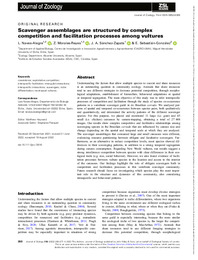Por favor, use este identificador para citar o enlazar este ítem:
https://hdl.handle.net/11000/33920Registro completo de metadatos
| Campo DC | Valor | Lengua/Idioma |
|---|---|---|
| dc.contributor.author | Naves Alegre, Lara | - |
| dc.contributor.author | Morales-Reyes, Zebensui | - |
| dc.contributor.author | Sanchez-Zapata, Jose Antonio | - |
| dc.contributor.author | Sebastian-González, E. | - |
| dc.contributor.other | Departamentos de la UMH::Biología Aplicada | es_ES |
| dc.date.accessioned | 2024-11-19T09:49:35Z | - |
| dc.date.available | 2024-11-19T09:49:35Z | - |
| dc.date.created | 2022 | - |
| dc.identifier.citation | Journal of Zoology 318 (2022) 260–271 | es_ES |
| dc.identifier.issn | 1469-7998 | - |
| dc.identifier.issn | 0952-8369 | - |
| dc.identifier.uri | https://hdl.handle.net/11000/33920 | - |
| dc.description.abstract | Understanding the factors that allow multiple species to coexist and share resources is an outstanding question in community ecology. Animals that share resources tend to use different strategies to decrease potential competition, through morphological adaptations, establishment of hierarchies, behavioral adaptations or spatial or temporal segregation. The main objective of this study was to infer interspecific processes of competition and facilitation through the study of species co-occurrence patterns in a vertebrate scavenger guild in de Brazilian cerrado. We analyzed patterns of spatial and temporal co-occurrence between species pairs, both qualitatively and quantitatively, and determined the activity patterns of the different scavenger species. For this purpose, we placed and monitored 11 large (i.e. goat) and 45 small (i.e. chicken) carcasses by camera-trapping, obtaining a total of 27 448 images. Our results show complex competitive and facilitative relationships among scavenging species in the Brazilian cerrado that are influenced by carcass size and change depending on the spatial and temporal scale at which they are analyzed. The scavenger assemblages that consumed large and small carcasses were different, evidencing resource partitioning between obligate and facultative scavengers. Furthermore, as an alternative to reduce competition levels, most species showed differences in their scavenging patterns, in addition to a strong temporal segregation during carcass consumption. Regarding New World vultures, our results suggest a strong interference competition between species with clear differences in their ecological traits (e.g. size, social behavior). However, we also found evidence of facilitation processes between vulture species in the location and access to the interior of the carcasses. Our findings highlight the role of obligate scavengers both in competition and facilitation processes in this vertebrate scavenger community. Future research should focus on investigating which species play the most important role in the structure and dynamics of this community, also considering intraspecific and behavioral patterns. | es_ES |
| dc.format | application/pdf | es_ES |
| dc.format.extent | 12 | es_ES |
| dc.language.iso | eng | es_ES |
| dc.publisher | Wiley | es_ES |
| dc.rights | info:eu-repo/semantics/openAccess | es_ES |
| dc.rights | Attribution-NonCommercial-NoDerivatives 4.0 Internacional | * |
| dc.rights.uri | http://creativecommons.org/licenses/by-nc-nd/4.0/ | * |
| dc.subject | coexistence | es_ES |
| dc.subject | exploitative competition | es_ES |
| dc.subject | interspecific facilitation | es_ES |
| dc.subject | inter-guild interactions | es_ES |
| dc.subject | interspecific interactions | es_ES |
| dc.subject.other | CDU::5 - Ciencias puras y naturales::57 - Biología | es_ES |
| dc.title | Scavenger assemblages are structured by complex competition and facilitation processes among vultures | es_ES |
| dc.type | info:eu-repo/semantics/article | es_ES |
| dc.relation.publisherversion | https://doi.org/10.1111/jzo.13016 | es_ES |

Ver/Abrir:
37.pdf
1,03 MB
Adobe PDF
Compartir:
 La licencia se describe como: Atribución-NonComercial-NoDerivada 4.0 Internacional.
La licencia se describe como: Atribución-NonComercial-NoDerivada 4.0 Internacional.
.png)